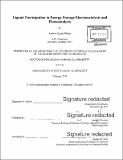| dc.contributor.advisor | Daniel G. Nocera. | en_US |
| dc.contributor.author | Maher, Andrew Gerard | en_US |
| dc.contributor.other | Massachusetts Institute of Technology. Department of Chemistry. | en_US |
| dc.date.accessioned | 2018-05-23T16:35:36Z | |
| dc.date.available | 2018-05-23T16:35:36Z | |
| dc.date.copyright | 2018 | en_US |
| dc.date.issued | 2018 | en_US |
| dc.identifier.uri | http://hdl.handle.net/1721.1/115804 | |
| dc.description | Thesis: Ph. D. in Physical Chemistry, Massachusetts Institute of Technology, Department of Chemistry, 2018. | en_US |
| dc.description | Cataloged from PDF version of thesis. | en_US |
| dc.description | Includes bibliographical references. | en_US |
| dc.description.abstract | The electrochemical or photochemical production of fuels using energy from the sun is an attractive approach for storing solar energy. However, the development of efficient and inexpensive catalysts is necessary to facilitate these reactions. While a number of molecular catalysts do exist for this purpose, a lack of deep understanding of how they operate on a mechanistic level impedes their optimization and rational design. This thesis addresses the key mechanistic issue of ligand participation during energy storage catalysis using electrochemical, spectroscopic (both steady-state and time-resolved), synthetic, and computational techniques. The thesis begins by investigating the reactivity of nickel porphyrins during the electrocatalytic generation of hydrogen from acid. Rather than forming a traditional metal-hydride intermediate, nickel porphyrins are found to be protonated on the macrocycle ligand to first form a phlorin intermediate and ultimately a doubly-hydrogenated isobacteriochlorin species. The Ni isobacteriochlorin serves as the active hydrogen evolution catalyst, with ring reduction of the ligand necessary to drive metal-hydride formation. A synthetic cobalt chlorin in which the ring reduction is structurally enforced is then investigated. The cobalt chlorin also generates hydrogen electrochemically, and a mechanistic study reveals a greater intrinsic activity than metal porphyrins when compared at low overpotentials, likely due to an increased hydricity imparted by the highly-reduced ligand. The thesis then turns to the role of direct ligand reactivity in enhancing the photoreactivity of monomeric nickel complexes. Transient absorption (TA) spectroscopic studies reveal that the triphenylphosphine ligand of Ni halide hydrogen-evolving photocatalysts serves as the photosensitizer and as a redox mediator in what is determined to be a tandem cycle. TA also demonstrates the role of halogen-arene charge transfer intermediates in increasing the quantum yield of halogen photoelimination by Ni(III) trichloride complexes containing bidendate phosphine ligands that include aryl groups. The thesis concludes with an examination of the electron transfer kinetics of a soluble form of peroxide dianion stabilized by a hydrogen-bonding cryptand ligand. Ultrafast oxidation of the peroxide using photosensitizers of varying oxidizing power allows for measurement of the inner-sphere reorganization energy, which is dominated by the contraction of the O-O bond. | en_US |
| dc.description.statementofresponsibility | by Andrew Gerard Maher. | en_US |
| dc.format.extent | 249 pages | en_US |
| dc.language.iso | eng | en_US |
| dc.publisher | Massachusetts Institute of Technology | en_US |
| dc.rights | MIT theses are protected by copyright. They may be viewed, downloaded, or printed from this source but further reproduction or distribution in any format is prohibited without written permission. | en_US |
| dc.rights.uri | http://dspace.mit.edu/handle/1721.1/7582 | en_US |
| dc.subject | Chemistry. | en_US |
| dc.title | Ligand participation in energy storage electrocatalysis and photocatalysis | en_US |
| dc.type | Thesis | en_US |
| dc.description.degree | Ph. D. in Physical Chemistry | en_US |
| dc.contributor.department | Massachusetts Institute of Technology. Department of Chemistry | |
| dc.identifier.oclc | 1036988266 | en_US |
